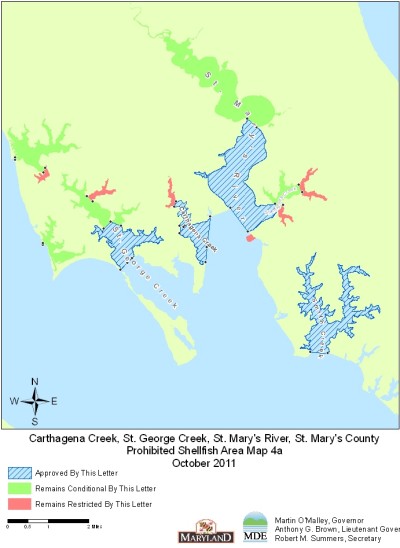
This map depicts an area of the St. Mary’s River and parts of other nearby waterways that have been reclassified by the state to allow oysters and clams to be harvested at any time. (Source: MDE)
BALTIMORE (October 17, 2011) – The Maryland Department of the Environment is reclassifying an area of the St. Mary’s River and parts of other nearby waterways to allow oysters and clams to be harvested at any time. The change – which is effective Monday, October 17 – is based on a recent evaluation that showed decreased levels of bacteria in the waterways.
The areas have been reclassified to “approved” for shellfish harvesting. They had been previously classified as “conditionally approved.” Under the “conditionally approved” classification, oysters and clams can not be harvested for three days following a rainfall event of one inch or greater over 24 hours. They can be harvested at all other times.
The areas reclassified from conditionally approved to approved are: the St. Mary’s River downstream of Pagan Point; parts of St. Inigoes Creek; a portion of Carthagena Creek; a portion of St. George Creek; and all of Smith Creek.
The headwaters of the St. Mary’s River and St. George Creek will remain conditionally approved for shellfish harvesting. Locust Grove Cove in St. George Creek, Molls Cove, and the headwaters of St. Inigoes Creek and Carthagena Creek will remain closed to harvesting.
MDE monitors bacteriological water quality and conducts pollution source surveys to determine which areas are safe for the harvesting of shellfish. The Department is required to close areas that do not meet the strict water quality standards for shellfish harvesting waters and it has a longstanding policy to reopen areas to shellfish harvesting when water quality improves. These actions ensure Maryland maintains its reputation for safe and wholesome seafood products and remains in compliance with the National Shellfish Sanitation Program.
A recent evaluation of shellfish harvesting waters showed decreased bacteria levels. Information from the most recent survey of pollution sources in the area also supported a reclassification to “approved.” MDE will continue to monitor water quality in the area.
Shellfish (oysters and clams) are filter feeders with the ability to filter water and get food from microscopic organisms in the water. If the waters are polluted, this filtering process can concentrate viruses or bacteria that are potentially harmful to people. Oysters and clams are often eaten raw or partially cooked and must come from waters that are not polluted.
Source: Maryland Department of the Environment


